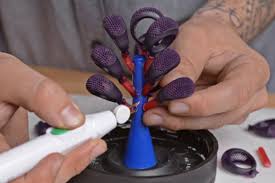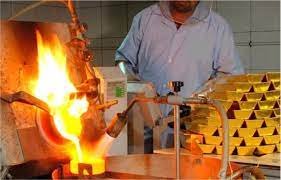Wax tree maker
SECTOR: GEMS & JEWELLERY
SUB-SECTOR: Cast and Diamonds-Set Jewellery
OCCUPATION: Wax model making
REFERENCE ID: G&J/Q2601
ALIGNED TO: NCO-NIL
Wax tree maker: A wax tree maker assembles wax replicas of jewellery
pieces on to a wax tree with a central sprue. The tree is placed in the
investment mould for casting process where the melted wax leaves cavities
in the cast and molten metal is poured in for adopting the shape of the
cavities left by the wax. Since the shape of the assembled wax pieces
resembles a tree, hence the name, wax tree.
Brief Job Description: A wax tree maker works with different types of waxes,
wax soldering machine and consumables in order to assemble wax pieces in a
tree like structure.
Personal Attributes: The job requires the individual to have: attention to
details; good eyesight; steady hands; quick response; ability to work in a
process driven team and for long hours in sitting position. The individual
must also have problem solving skills in order to avert machine failures,
errors and hazards.
Unit Code G&J/N2601
Unit Title
(Task) Make the wax tree
Description This OS unit is about assembling wax replica of jewellery components by soldering
wax pieces on central wax sprue, in order to use it for mass production of jewellery
piece through casting process
Scope This unit/task covers the following:
Receive the wax pieces, consumables and instructions from supervisor
collect wax pieces, including studded with diamond and gemstones
count the number of pieces and match with the job sheet
read the instructions for number and type of wax pieces to be assembled on a
wax tree
select the type of central sprue as per design specified by the product
development department or job sheet
Clean and check each wax piece
inspect all wax pieces for signs of defects or blemishes and missing diamonds
and gemstones to avoid transporting defects to the metal cast jewellery
clean and smooth wax patterns in preparation for making wax tree
Make the wax tree as per job sheet
select the rubber base for the tree, preferably in a conical shape
clean the rubber base and check for any residue and defects
use QC okayed rubber base
select central sprue with lower melting range than the wax pieces, so that
central stem melts first in the burnout cycle and help avoid stress in the
invested flask
select sprue with optimised dimension (tapered diameter is preferred), which
helps reduce weight of alloy used in the casting process
fit rubber base to the central sprue
arrange the wax pieces to be assembled, e.g., thin or lighter wax pieces at top
or complex designs at top
join the wax piece sprue to the central sprue by soldering at the recommended
angle of, say, 45o – 60o
measure the weight of the assembled tree and note in the job sheet
Return prepared wax tree to supervisor
self-check each wax tree for angle and spacing between the wax pieces
ensure timely delivery of the required number of quality okayed trees
Report problems related to:
missing diamonds and gemstones on the wax pieces
imperfect wax pieces
completely different wax pieces in terms of its shape, size and weight are
assigned for the same wax tree
shortage of wax, consumables and tools
reasons for anticipated delays that may adversely affect delivery
Interact with superior or master model maker to:
receive instructions and materials from reporting supervisor
Element Performance Criteria
Wax tree making To be competent, the user/individual on the job must be able to:
PC1. select appropriate rubber base and central sprue
PC2. select appropriate length of the sprue for the number of wax pieces
PC3. assemble wax pieces according to instructions and standard operating
procedure in terms of sequence, angle and spacing of the wax pieces
Productivity To be competent, the user/individual on the job must be able to:
PC4. timely deliver wax pieces to next process
PC5. produce number of wax tree per day as per target given
PC6. ensure damage free output with minimal hazards
Quality of output To be competent, the user/individual on the job must be able to:
PC7. inspect all wax pieces, rubber base, nozzle and central sprue for imperfect
surface finishing
PC8. solder wax piece to central sprue without damaging wax pieces
PC9. produce wax tree is quality okayed
A. Organizational
Context
The user/individual on the job needs to know and understand:
KA1. company’s policies on: quality, incentives, delivery standards, safety and
hazards, integrity and IPR, and personnel management
KA2. importance of the individual’s role in the workflow
KA3. reporting structure
B. Technical
Knowledge
The user/individual on the job needs to know and understand:
KB1. different types of wax and their properties, particularly, with respect to
heat and pressure sensitivity
KB2. uses of different qualities of wax and its properties in terms of shrinkage
KB3. different types of central sprue and rubber base
KB4. potential work hazards, particularly, when using wax soldering machine
and sharp tools
A. Core Skills/ Generic
Skills
Basic reading and writing skills
The user/ individual on the job needs to know and understand how to:
SA1. read notes, designs and instructions on job sheet
SA2. read company rules and compliance documents required to complete the
work
Make the wax tree
Calculation and Geometry skills
The user/individual on the job needs to know and understand how to:
SA3. count the number of wax pieces to be assembled on the same wax tree
SA4. assess accuracy of alignment and measure symmetry
Teamwork and multitasking
The user/individual on the job needs to know and understand how to:
SA5. share work load when multiple deliverables are required
SA6. deliver the wax tree to next work process on time
B. Professional Skills Understanding wax and other consumables
The user/individual on the job needs to know and understand:
SB1. wax types and its properties
SB2. dimensions of central stem and rubber base
SB3. prescribed melting temperature of the different types of wax
Using tools and machines
The user/individual on the job needs to know and understand how:
SB4. to use the wax soldering machine
SB5. to work in a safe environment, i.e., without injuries
Reflective thinking
The user/individual on the job needs to know and understand how to:
SB6. improve work processes or greater productivity
SB7. inspect all wax pieces, rubber base, nozzle and central stem for imperfect
surface finishing
SB8. self-check each wax tree for angle and spacing between the wax pieces
Critical thinking
The user/individual on the job needs to know and understand how to:
SB9. anticipate process disruption and reasons for delay
Unit Code G&J/N9901
Unit Title
(Task) Maintain IPR of company and respect IPR of other companies
Description This OS unit is about protecting company’s IPR and avoiding infringement to IPR of
other companies
Scope This unit/task covers the following:
Protect company’s Intellectual Property Rights (IPR)
prevent leak of new designs to competitors by reporting on time
be aware of any of company’s product or design patents
report IPR violations observed in the market, to supervisor or company heads
Avoid infringement to IPR of other companies
read copyright clause of the material published on the internet and any other
printed material
consult supervisor or senior management when in doubt about using publicly
available information
report any infringement observed in the company
Element Performance Criteria
Respecting and
Maintaining IPR
To be competent, the user/individual on the job must:
PC1. be able to spot plagiarism and report
PC2. be aware of patents and IPR
PC3. not be involved in IPR violations
A. Organizational
Context
The user/individual on the job needs to know and understand:
KA1. company’s policies on IPR and plagiarism
KA2. reporting structure
KA3. company’s unique product range
B. Technical
Knowledge
The user/individual on the job needs to know and understand:
KB1. patents and IPR laws
KB2. how IPR protection is important for competitiveness of a company
A. Core Skills/
Generic Skills
Communication skills
The user/ individual on the job needs to know and understand how to:
SA1. effectively communicate any observed IPR violations or order leaks
B. Professional Skills Decision making
The user/individual on the job needs to know and understand how to:
SA2. report potential sources of violations
Reflective thinking
The user/individual on the job needs to know and understand to:
SA3. learn from past mistakes and report IPR violations on time
Critical thinking
The user/individual on the job needs to know and understand how to:
SA4. spot signs of violations and alert authorities in time
Unit Code G&J/N9902
Unit Title
(Task) Interact with colleagues and seniors
Description This OS unit is about communicating with colleagues and seniors in order to achieve
smooth and hazard-free work flow
Scope This unit/task covers the following:
Interact with supervisor
receive work instructions and raw materials from reporting supervisor
communicate to reporting supervisor about process-flow improvements, product
defects received from previous process, repairs and maintenance of tools and
machinery as required
communicate any potential hazards or expected process disruptions
handover completed work to supervisor
Interact with colleagues within and outside the department
work as a team with colleagues and share work as per their or own work load and
skills
work with colleagues of other departments
communicate and discuss work flow related difficulties in order to find solutions
with mutual agreement
receive feedback from qc and rework in order to complete work on time
Element Performance Criteria
Interaction with
supervisor
To be competent, the user/individual on the job must be able to:
PC1. understand the work output requirements
PC2. comply with company policy and rule
PC3. deliver quality work on time as required by reporting any anticipated reasons
for delays
Interactions with
colleagues and other
departments
To be competent, the user/individual on the job must be able to:
PC4. put team over individual goals
PC5. be able to resolve conflicts
PC6. learn how to multi-task relevant activities
Knowledge and Understanding (K)
A. Organizational
Context
The user/individual on the job needs to know and understand:
KA1. company’s policies on: preferred language of communication, reporting and
escalation policy, quality delivery standards, and personnel management
KA2. reporting structure
B. Technical
Knowledge
The user/individual on the job needs to know and understand how to:
KB1. communicate effectively
KB2. build team coordination
A. Core Skills/
Generic Skills
Communication skills
The individual on the job needs to know and understand how to:
SA1. read and write preferred language of communication as prescribed by the
company
SA2. read job sheets and interpret technical details mentioned in the job sheet
B. Professional Skills Decision making
The individual on the job needs to know and understand:
SB1. how to spot and communicate potential areas of disruptions to work process
and report the same
SB2. when to report to supervisor and when to deal with a colleague individually,
depending on the type of concern
Reflective thinking
The individual on the job needs to know and understand how to:
SB3. improve work processes by interacting with others and adopting best
practices
Critical thinking
The individual on the job needs know and understand how to:
SB4. spot process disruptions and delays and report and communicate with
solutions
Unit Code G&J/N9905
Unit Title
(Task) Maintain occupational health and safety
Description This OS unit is about being aware of, communicating and taking steps towards
minimizing potential hazards and dangers of accidents on the job and maintaining
occupational health and safety
Scope This unit/task covers the following:
Understand potential sources of accidents
to avoid accidents related to use of potentially dangerous chemicals, sharp tools
and machines
Use safety gear to avoid accidents
wear safety gear such as goggles, mask, gloves, ear plugs
Actively participate in the health and safety awareness campaigns
attend fire drills organised by the company or industrial zone
learn first aid procedure
be alert about designated assembly area in the event of an emergency
read and understand the evacuation and emergency procedures
Communicate to reporting supervisor about:
process flow improvements that can reduce anticipated or repetitive hazards
mishandling of tools, machines or hazardous materials
electrical problems that could result in accident
Performance Criteria(PC) w.r.t. the Scope
Element Performance Criteria
Communicating
potential accident
points
To be competent, the user/individual on the job must be able to:
PC1. spot and report potential hazards on time
PC2. follow company policy and rules regarding use of hazardous materials
PC3. attend and actively participate in the health and safety campaigns organised
by the company
Using safety gear To be competent, the user/individual on the job must be able to:
PC4. use or wear safety gear as per the rules of the company
Knowledge and Understanding (K)
A. Organizational
Context
The user/individual on the job needs to know and understand:
KA1. company’s policies on: safety and hazards and personnel management
KA2. reporting structure
B. Technical
Knowledge
The user/individual on the job needs to know and understand:
KB1. how different chemicals react and what could be the danger from them
KB2. how to use machines and tools without suffering bodily harm
Skills (S) [Optional]
A. Core Skills/
Generic Skills
Communication skills
The individual on the job needs to know and understand how to:
SA1. effectively communicate the danger
Organising skills
The individual on the job needs to know and understand how to:
SA2. keep all the tools in an organised manner so as to avoid accidents
SA3. keep the work environment safe and clean
B. Professional Skills Decision making
The individual on the job needs to know and understand how to:
SB1. report potential sources of danger
SB2. follow prescribed procedure in the event of an accident
SB3. wear appropriate safety gear to avoid an accident
Reflective thinking
The individual on the job needs to know and understand to:
SB4. learn from past mistakes regarding use of hazardous machines or chemicals
Critical thinking
The individual on the job needs to know and understand how to:
SB5. spot danger
Decision making
The individual on the job needs to know and understand how to:
SB6. report potential sources of danger
SB7. follow prescribed procedure in the event of an accident
SB8. wear appropriate safety gear to avoid an accident
Keywords /Terms Description
Sector Sector is a conglomeration of different business operations having similar
business and interests. It may also be defined as a distinct subset of the
economy whose components share similar characteristics and interests.
Sub-sector Sub-sector is derived from a further breakdown based on the
characteristics and interests of its components.
Occupation Occupation is a set of job roles, which perform similar/ related set of
functions in an industry.
Function Function is an activity necessary for achieving the key purpose of the
sector, occupation, or an area of work, which can be carried out by a
person or a group of persons. Functions are identified through functional
analysis and form the basis of OS.
Sub-function Sub-functions are sub-activities essential to fulfil the achieving the
objectives of the function.
Job role Job role defines a unique set of functions that together form a unique
employment opportunity in an organisation.
Occupational Standards
(OS)
OS specify the standards of performance an individual must achieve
when carrying out a function in the workplace, together with the
knowledge and understanding they need to meet that standard
consistently. Occupational Standards are applicable both in the Indian
and global contexts.
Performance Criteria Performance criteria are statements that together specify the standard of
performance required when carrying out a task.
National Occupational
Standards (OS)
NOS are occupational standards which apply uniquely in the Indian
context.
Qualifications Pack (QP) QP comprises the set of OS, together with the educational, training and
other criteria required to perform a job role. A QP is assigned a unique
qualifications pack code.
Unit Code Unit code is a unique identifier for an Occupational Standard, which is
denoted by an ‘N’
Unit Title Unit title gives a clear overall statement about what the incumbent
should be able to do.
Description Description gives a short summary of the unit content. This would be
helpful to anyone searching on a database to verify that this is the
appropriate OS they are looking for.
Scope Scope is a set of statements specifying the range of variables that an
individual may have to deal with in carrying out the function which have
a critical impact on quality of performance required.
Knowledge and
Understanding
Knowledge and understanding are statements which together specify the
technical, generic, professional and organisational specific knowledge
that an individual needs in order to perform to the required standard.
Organisational Context Organisational context includes the way the organisation is structured
and how it operates, including the extent of operative knowledge
managers have of their relevant areas of responsibility.
Technical Knowledge Technical knowledge is the specific knowledge needed to accomplish
specific designated responsibilities.
Core Skills/ Generic
Skills
Core skills or generic skills are a group of skills that are the key to learning
and working in today’s world. These skills are typically needed in any
work environment in today’s world. These skills are typically needed in
any work environment. In the context of the OS, these include
communication related skills that are applicable to most job roles.
Keywords /Terms Description
CAD Computer Aided Design
CAM Computer Aided Manufacturing
IPR Intellectual Property Rights
NOS National Occupational Standard(s)
NVQF National Vocational Qualifications Framework
NSQF National Qualifications Framework
NVEQF National Vocational Education Qualifications Framework
QP Qualifications Pack
CRITERIA FOR ASSESSMENT OF TRAINEES
Job Role Wax Tree Maker
Qualification Pack G&J/Q2601
Sector Skill Council Gem & Jewellery
Guidelines for Assessment
- Criteria for assessment for each Qualification Pack will be created by the Sector Skill Council. Each
Performance Criteria (PC) will be assigned marks proportional to its importance in NOS. SSC will also lay down
proportion of marks for Theory and Skills Practical for each PC. - The assessment for the theory part will be based on knowledge bank of questions created by the SSC.
- Individual assessment agencies will create theory question papers for candidates at every
examination/training centre. (as per assessment criteria below) - Individual assessment agencies will create practical tests for skill evaluation for candidates at every
examination/training centre. (as per assessment criteria below) - To pass the Qualification Pack, every candidate should score a minimum of 50% in theory and 70% in
practical to successfully clear the assessment. - In case of successfully passing only certain number of NOS’s, the candidate is eligible to take subsequent
assessment on the balance NOS’s to pass the Qualification Pack.









